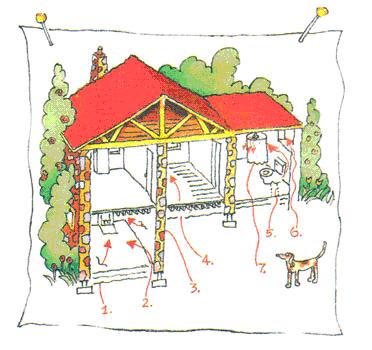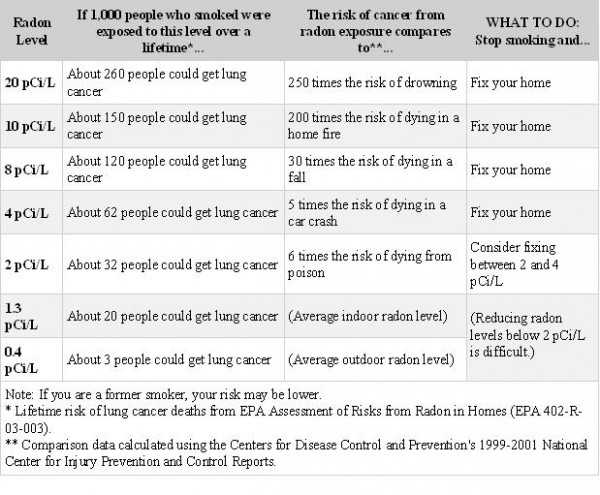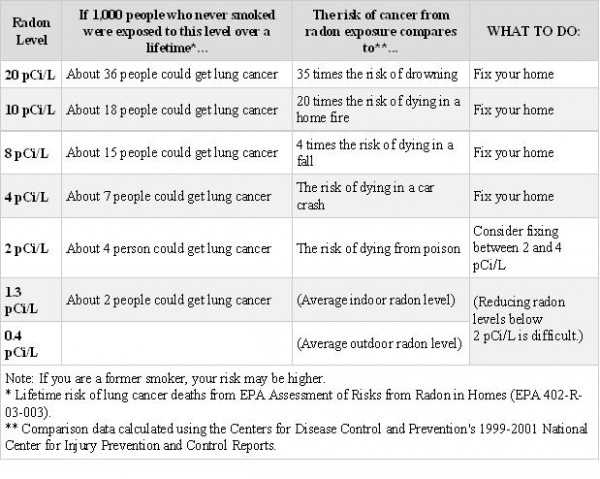RADON
All Home Buyer’s Should Consider Having A Radon Test With Their Home Inspection
Radon is a cancer-causing, radioactive gas.
You can’t see radon. And you can’t smell it or taste it. But it may be a problem in your home.Radon is estimated to cause many thousands of deaths each year. That’s because when you breathe air containing radon, you can get lung cancer. In fact, the Surgeon General has warned that radon is the second leading cause of lung cancer in the United States today. Only smoking causes more lung cancer deaths. If you smoke and your home has high radon levels, your risk of lung cancer is especially high.
Radon can be found in New Jersey and all over the U.S.
Radon comes from the natural (radioactive) breakdown of uranium in soil, rock and water and gets into the air you breathe. Radon can be found all over the U.S. It can get into any type of building – homes, offices, and schools – and result in a high indoor radon level. But you and your family are most likely to get your greatest exposure at home, where you spend most of your time.
You should test for radon.
Testing is the only way to know if you and your family are at risk from radon. EPA and the Surgeon General recommend testing all homes below the third floor for radon. EPA also recommends testing in schools.
Testing is inexpensive and easy – it should only take a few minutes of your time. Millions of Americans have already tested their homes for radon (see How to Test Your Home).
You can fix a radon problem.
Radon reduction systems work and they are not too costly. Some radon reduction systems can reduce radon levels in your home by up to 99%. Even very high levels can be reduced to acceptable levels.
New homes can be built with radon-resistant features.
Radon-resistant construction techniques can be effective in preventing radon entry. When installed properly and completely, these simple and inexpensive techniques can help reduce indoor radon levels in homes. In addition, installing them at the time of construction makes it easier and less expensive to reduce radon levels further if these passive techniques don’t reduce radon levels to below 4 pCi/L. Every new home should be tested after occupancy, even if it was built radon-resistant. If radon levels are still in excess of 4 pCi/L, the passive system should be activated by having a qualified mitigator install a vent fan. For more explanation of radon resistant construction techniques, refer to EPA publication, Building Radon Out: A Step-by-Step Guide on How to Build Radon-Resistant Homes (see www.epa.gov/radon/rrnc).
How Does Radon Get Into Your Home?
Any home may have a radon problem
Radon is a radioactive gas. It comes from the natural decay of uranium that is found in nearly all soils. It typically moves up through the ground to the air above and into your home through cracks and other holes in the foundation. Your home traps radon inside, where it can build up. Any home may have a radon problem. This means new and old homes, well-sealed and drafty homes, and homes with or without basements.
Radon from soil gas is the main cause of radon problems. Sometimes radon enters the home through well water. In a small number of homes, the building materials can give off radon, too. However, building materials rarely cause radon problems by themselves.
RADON GETS IN THROUGH:
1. Cracks in solid floors
2. Construction joints
3. Cracks in walls
4. Gaps in suspended floors
5. Gaps around service pipes
6. Cavities inside walls
7. The water supply
Nearly 1 out of every 15 homes in the U.S. is estimated to have elevated radon levels. Elevated levels of radon gas have been found in homes in your state. While radon problems may be more common in some areas, any home may have a problem. The only way to know about your home is to test.
Radon can also be a problem in schools and workplaces. Ask your state radon office about radon problems in schools, daycare and childcare facilities, and workplaces in your area.
How to Test Your Home
You can’t see radon, but it’s not hard to find out if you have a radon problem in your home. All you need to do is test for radon. Testing is easy and should only take a few minutes of your time.
The amount of radon in the air is measured in “picocuries per liter of air,” or “pCi/L.” There are many kinds of low-cost “do-it-yourself” radon test kits you can get through the mail and in hardware stores and other retail outlets.
If you prefer, or if you are buying or selling a home, you can hire a qualified tester to do the testing for you. You should first contact your state radon office about obtaining a list of qualified testers. You can also contact a private radon proficiency program for lists of privately certified radon professionals serving your area..
There are Two General Ways to Test for Radon:
SHORT-TERM TESTING:
The quickest way to test is with short-term tests. Short-term tests remain in your home for two days to 90 days, depending on the device. “Charcoal canisters,” “alpha track,” “electret ion chamber,” “continuous monitors,” and “charcoal liquid scintillation” detectors are most commonly used for short-term testing. Because radon levels tend to vary from day to day and season to season, a short-term test is less likely than a long-term test to tell you your year-round average radon level. If you need results quickly, however, a short-term test followed by a second short-term test may be used to decide whether to fix your home.
How To Use a Test Kit:
Testing is easy and should only take a few minutes of your time.
Follow the instructions that come with your test kit. If you are doing a short-term test, close your windows and outside doors and keep them closed as much as possible during the test. Heating and air-conditioning system fans that re-circulate air may be operated. Do not operate fans or other machines which bring in air from outside. Fans that are part of a radon-reduction system or small exhaust fans operating only for short periods of time may run during the test.
If you are doing a short-term test lasting just 2 or 3 days, be sure to close your windows and outside doors at least 12 hours before beginning the test, too. You should not conduct short-term tests lasting just 2 or 3 days during unusually severe storms or periods of unusually high winds. The test kit should be placed in the lowest lived-in level of the home (for example, the basement if it is frequently used, otherwise the first floor). It should be put in a room that is used regularly (like a living room, playroom, den or bedroom) but not your kitchen or bathroom.
Place the kit at least 20 inches above the floor in a location where it won’t be disturbed – away from drafts, high heat, high humidity, and exterior walls. Leave the kit in place for as long as the package says. Once you’ve finished the test, reseal the package and send it to the lab specified on the package right away for analysis. You should receive your test results within a few weeks.
LONG-TERM TESTING:
Long-term tests remain in your home for more than 90 days. “Alpha track” and “electret” detectors are commonly used for this type of testing. A long-term test will give you a reading that is more likely to tell you your home’s year-round average radon level than a short-term test.
EPA Recommends the Following Testing Steps:
Step 1. Take a short-term test. If your result is 4 pCi/L or higher take a follow-up test (Step 2) to be sure.
Step 2. Follow up with either a long-term test or a second short-term test:
For a better understanding of your year-round average radon level, take a long-term test.
If you need results quickly, take a second short-term test.
The higher your initial short-term test result, the more certain you can be that you should take a short-term rather than a long-term follow up test. If your first short-term test result is more than twice EPA’s 4 pCi/L action level, you should take a second short-term test immediately.
Step 3. If you followed up with a long-term test: Fix your home if your long-term test result is 4 pCi/L or more. If you followed up with a second short-term test: The higher your short-term results, the more certain you can be that you should fix your home. Consider fixing your home if the average of your first and second test is 4 pCi/L or higher.
What Your Test Results Mean
Test your home now and save your results. If you find high radon levels, fix your home before you decide to sell it.
The average indoor radon level is estimated to be about 1.3 pCi/L, and about 0.4 pCi/L of radon is normally found in the outside air. The U.S. Congress has set a long-term goal that indoor radon levels be no more than outdoor levels. While this goal is not yet technologically achievable in all cases, most homes today can be reduced to 2 pCi/L or below.
Sometimes short-term tests are less definitive about whether or not your home is above 4 pCi/L. This can happen when your results are close to 4 pCi/L. For example, if the average of your two short-term test results is 4.1 pCi/L, there is about a 50% chance that your year-round average is somewhat below 4 pCi/L. However, EPA believes that any radon exposure carries some risk – no level of radon is safe. Even radon levels below 4 pCi/L pose some risk, and you can reduce your risk of lung cancer by lowering your radon level.
If your living patterns change and you begin occupying a lower level of your home (such as a basement) you should retest your home on that level.
Even if your test result is below 4 pCi/L, you may want to test again sometime in the future.
Radon and Home Sales
More and more, home buyers and renters are asking about radon levels before they buy or rent a home. Because real estate sales happen quickly, there is often little time to deal with radon and other issues. The best thing to do is to test for radon NOW and save the results in case the buyer is interested in them. Fix a problem if it exists so it won’t complicate your home sale. If you are planning to move, call your state radon office for EPA’s pamphlet.
During home sales:
- Buyers often ask if a home has been tested, and if elevated levels were reduced.
- Buyers frequently want tests made by someone who is not involved in the home sale. Your state radon office can assist you in identifying a qualified tester
- Buyers might want to know the radon levels in areas of the home (like a basement they plan to finish) that the seller might not otherwise test.
Today many homes are built to prevent radon from coming in. Your state or local area may require these radon-resistant construction features. If you are buying or renting a new home, ask the owner or builder if it has radon-resistant features. The EPA recommends building new homes with radon-resistant features in high radon potential (Zone 1) areas.
Even if built radon-resistant, every new home should be tested for radon after occupancy. If you have a test result of 4 pCi/L or more, you can have a qualified mitigator easily add a vent fan to an existing passive system for about $300 and further reduce the radon level in your home. For more information, refer to and other useful EPA documents on radon-resistant new construction
Radon in Water
If you’ve tested the air in your home and found a radon problem, and your water comes from a well, have your water tested.
There are two main sources for the radon in your home’s indoor air, the soil and the water supply. Compared to radon entering the home through water, radon entering your home through the soil is usually a much larger risk.
The radon in your water supply poses an inhalation risk and an ingestion risk. Research has shown that your risk of lung cancer from breathing radon in air is much larger than your risk of stomach cancer from swallowing water with radon in it. Most of your risk from radon in water comes from radon released into the air when water is used for showering and other household purposes.
Radon in your home’s water is not usually a problem when its source is surface water. A radon in water problem is more likely when its source is ground water, e.g. a private well or a public water supply system that uses ground water.
If you are concerned that radon may be entering your home through the water and your water comes from a public water supply, contact your water supplier.
If you’ve tested your private well and have a radon in water problem, it can be fixed. Your home’s water supply can be treated in two ways. Point-of-entry treatment can effectively remove radon from the water before it enters your home. Point-of-use treatment devices remove radon from your water at the tap, but only treat a small portion of the water you use and are not effective in reducing the risk from breathing radon released into the air from all water used in the home.
How to Lower the Radon Levels in Your Home
Since there is no known safe level of radon, there can always be some risk. But the risk can be reduced by lowering the radon level in your home.
There are several proven methods to reduce radon in your home, but the one primarily used is a vent pipe system and fan, which pulls radon from beneath the house and vents it to the outside. This system, known as a soil suction radon reduction system, does not require major changes to your home. Sealing foundation cracks and other openings makes this kind of system more effective and cost-efficient. Similar systems can also be installed in houses with crawl spaces. Radon contractors can use other methods that may also work in your home. The right system depends on the design of your home and other factors.
The cost of reducing radon in your home depends on how your home was built and the extent of the radon problem. Most homes can be fixed for about the same cost as other common home repairs. The cost to fix can vary widely; consult with your state radon office or get one or more estimates from qualified mitigators. The cost is much less if a passive system was installed during construction.
Radon and Home Renovations
If you are planning any major structural renovation, such as converting an unfinished basement area into living space, it is especially important to test the area for radon before you begin the renovation. If your test results indicate a radon problem, radon-resistant techniques can be inexpensively included as part of the renovation. Because major renovations can change the level of radon in any home, always test again after work is completed.
Lowering high radon levels requires technical knowledge and special skills. You should use a contractor who is trained to fix radon problems. A qualified contractor can study the radon problem in your home and help you pick the right treatment method.
Check with your state radon office for names of qualified or state certified radon contractors in your area. You can also contact private radon proficiency programs for lists of privately certified radon professionals in your area. Picking someone to fix your radon problem is much like choosing a contractor for other home repairs – you may want to get references and more than one estimate.
Most homes can be fixed for about the same cost as other common home repairs.
You should also test your home again after it is fixed to be sure that radon levels have been reduced. Most soil suction radon reduction systems include a monitor that will indicate whether the system is operating properly. In addition, it’s a good idea to retest your home every two years to be sure radon levels remain low.
Note: The diagram is a composite view of several mitigation options. The typical mitigation system usually has only one pipe penetration through the basement floor; the pipe may also be installed on the outside of the house.
The Risk of Living With Radon
Radon gas decays into radioactive particles that can get trapped in your lungs when you breathe. As they break down further, these particles release small bursts of energy. This can damage lung tissue and lead to lung cancer over the course of your lifetime. Not everyone exposed to elevated levels of radon will develop lung cancer. And the amount of time between exposure and the onset of the disease may be many years.
Like other environmental pollutants, there is some uncertainty about the magnitude of radon health risks. However, we know more about radon risks than risks from most other cancer-causing substances. This is because estimates of radon risks are based on studies of cancer in humans (underground miners).
Smoking combined with radon is an especially serious health risk. Stop smoking and lower your radon level to reduce your lung cancer risk.
Scientists are more certain about radon risks than from most other cancer-causing substances.
Children have been reported to have greater risk than adults of certain types of cancer from radiation, but there are currently no conclusive data on whether children are at greater risk than adults from radon.
Your chances of getting lung cancer from radon depend mostly on:
·How much radon is in your home
·The amount of time you spend in your home
·Whether you are a smoker or have never smoked
Radon Risk If You Smoke
Radon Risk If You’ve Never Smoked
About the Radon Section
The Department of Environmental Protection (DEP) Radon Section conducts a wide variety of outreach activities to educate the public on the risks of radon and how homes can be remediated. These activities include formal educational slide presentations on radon awareness, participation in exhibits, conventions, and company-sponsored safety awareness events.
A toll-free Information Line, (800) 648-0394, is maintained to provide information to the public on testing procedures and mitigation techniques. Free information packets are available upon request. The Radon Section has established regulations for the certification of radon measurement and mitigation businesses and their technical staffs to ensure the public has access to quality radon services.
By law, all companies conducting radon testing and mitigations in New Jersey must be certified by the DEP, as is View-Master Home Inspections of New Jersey.



